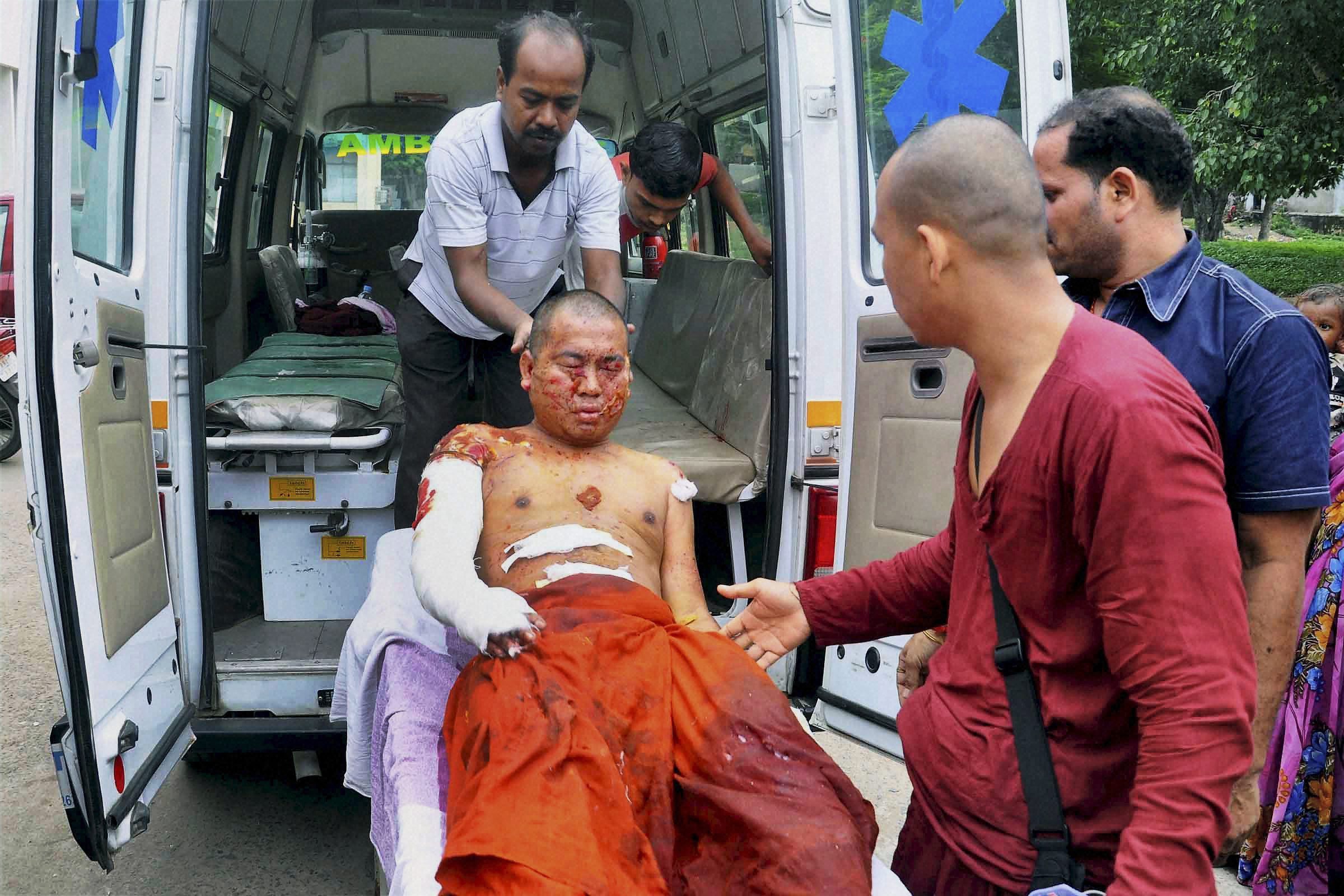
The facade remains ‘collective leadership’ but there has been a marked personalisation of political processes and parties. In the saffron camp, the accent is on Narendra Modi and the lotus — but deep down, it is the Modi-Amit Shah duo that rules the roost. The beleaguered Congress is stuck in the straitjacket of ‘the family’. The Samajwadi Party, for long caught in the contrasting siege of Mulayam Singh Yadav and Amar Singh, is now back to its eponymous Yadav profile. In a quintessentially one-leader formation, the imperious ‘Behenji’ has in recent years chosen to share some space with Satish Chandra Mishra in an attempt to give herself a sarvajan profile. All these combinations and partnerships, dictated as they are by immediate agendas, have, however, left a distinct political trail in their wake.

Narendra Modi & Amit Shah
Narendra Modi and Amit Shah led their party, the BJP, to an unprecedented victory in the 2014 Lok Sabha election. And their winning streak continues, as was seen in the recent Assembly polls in Maharashtra and Haryana. It was under the duo’s leadership that the party, which had been on the fringes on Haryana politics until then and had no prominent local leader, garnered a majority on its own and formed the government. In Maharashtra, it entered the fray after snapping ties with its longtime ally, the Shiv Sena. The gamble paid off as it emerged as the single largest party and went on to form a minority government.
The two stalwarts share a long political partnership in the saffron camp, going back at least two decades. Both of them had been attending RSS camps since their childhood and are said to have met for the first time at one such camp in Ahmedabad, Gujarat. While Modi came from a lower middle-class family, Shah had a more affluent background. As a young man, Modi is said to have left his family and wandered off to the Himalayas. Shah, on the other hand, joined his family business of share-trading and manufacturing of plastic pipes.
 Atal Bihari Vajpayee & Lal Krishna Advani
Atal Bihari Vajpayee & Lal Krishna Advani
The BJP is basking in the glory of success. The party is having a dream run ever since it won the 2014 General Election with a thumping majority. That unprecedented electoral success was followed by its historic double victory in the Haryana and Maharashtra Assembly polls. While Narendra Modi and Amit Shah have been credited with taking the party to such dizzying heights, another powerful duo — Atal Bihari Vajpayee and Lal Krishna Advani — had been responsible earlier for a breakthrough of comparable dimensions. They had been the driving force behind the BJP’s entry into the consciousness of the Indian electorate at a time when the Congress enjoyed a virtual monopoly over political power.
The Congress had built itself upon the legacy of leaders such as Pandit Jawaharlal Nehru and Sardar Vallabhbhai Patel, who had worked with Mahatma Gandhi during the freedom struggle. The party had penetrated every nook and corner of the country. But Vajpayee and Advani were among those who worked tirelessly to come up with a political alternative for the people of India. Where the BJP stands today owes a lot to their efforts.
 Sonia Gandhi & Ahmed Patel
Sonia Gandhi & Ahmed Patel
In his book The Accidental Prime Minister: The Making and Unmaking of Manmohan Singh, Sanjaya Baru, who was former prime minister Manmohan Singh’s media adviser, unveils several facts about Congress president Sonia Gandhi’s political secretary, 65-year-old Ahmed Patel, and his role in the party as well as the UPA government. Baru reveals that all political messages between Sonia and Manmohan Singh used to be routed through Patel. An increase in the frequency of his visits to the PM signalled an impending Cabinet reshuffle, writes Baru. Patel had the power to influence decision-making until the very end of the UPA regime. “On one occasion, he arrived at 7, Race Course Road just minutes before the PM’s letter to the President listing the names of MPs to be sworn in as ministers in a reshuffle was dispatched. Since the letter had been typed and signed and was ready to be delivered, and the President was waiting to receive it, it was decided that instead of wasting time retyping the letter, the new name being proposed by Patel would be typed over an existing name, which would be painted over with whitener,” writes Baru.
This incident shows the preeminent position Patel enjoys in the party and his closeness to Sonia. Patel had been a close aide of Sonia even before she stepped into politics. Often referred to as Sonia’s “crisis manager”, he is considered the most influential person in the party after the Gandhi family. “All roads to Sonia Gandhi pass through Ahmed Patel,” it is said.
 Mulayam Singh Yadav & Amar Singh
Mulayam Singh Yadav & Amar Singh
The contrast could not have been sharper. There was the leader, a quintessential Lohiaite breathing fire and brimstone. And there was this safari-suit-clad suitor fervently in pursuit of him, boasting of a lifestyle and connections that could not have been more contrarian. It was at a Kanpur industrialist’s house that Mulayam Singh Yadav was introduced to a certain Amar Singh — he of the gold cuff-links and phirangi cars, reeking of all the apparent signs of a five-star-variety socialite who frequented filmi parties and boasted of Bollywood connections, apart from several other attributes associated with such a type. The two came to be politically identified with each other in 1995 and, much to the chagrin of the Samajwadi Party rank and file, ‘Netaji’ actually managed to strike an instant rapport with someone so ostensibly different from the kind of people he had otherwise associated with in his political career.
The credit for the initial spadework in the relationship, say insiders, goes to the burly Amar Singh. He brandished his contacts and a silver tongue, and knew how to work political and corporate interests as also handle the English media, something that ‘Netaji’ found difficult. It did not take the two very long to travel a long distance from those early identities. Together, they made the Samajwadi Party a byword for opportunistic politics.
 Lalu Prasad Yadav & Nitish Kumar
Lalu Prasad Yadav & Nitish Kumar
A story is told of the first rally that the two of them addressed after a two-decade-long estrangement. There was the restrained and nervous Nitish Kumar, apparently hugely embarrassed by the compulsion to revisit a political ally for sheer survival. On the other hand was Lalu Prasad Yadav, chirpy and outspoken as ever, enjoying every minute of it. TV cameras had a field day picturing the two opposites, whose comeback into each other’s arms has had a cataclysmic impact. The two former chief ministers, who pursued diametrically opposed brands of politics for two decades, had now decided to bury the hatchet with a view to keep the Bharatiya Janata Party away from power in Bihar.
For Nitish, an alliance with Lalu was his second big gamble in just over a year. Last June, he had snapped his party’s 17-year-old alliance with the BJP after his béte noire Narendra Modi started emerging as the most formidable leader of his party. Pushed to the wall by the reverses in the Lok Sabha polls, Nitish took another risky gamble by tying up with the “tainted” Lalu.
 Mayawati & Satish Chandra Mishra
Mayawati & Satish Chandra Mishra
Right through her political career, Mayawati has had to periodically finetune the available options before her to stay afloat. This happened 20 years ago when ‘Behenji’ was only 39 years of age: a low-caste daughter of a postal clerk from Delhi, with no family connections or administrative experience, Mayawati had become chief minister of the biggest state in the country, leading the then prime minister PV Narasimha Rao to call it “a miracle of democracy”.
Her success was not hers alone. It indicated something deeper that had been building up for a long time in Independent India. Even four decades after Independence, the political landscape had failed to generate any political movement specifically centred around the Scheduled Castes. There had been some attempts, most prominent being BR Ambedkar’s Republican Party, but they consistently failed to take off. The advent of Kanshi Ram changed all that after he created an activist organisation called BAMCEF (Backward and Minority Communities Employees’ Federation) in the 1970s and then expanded the idea to a political group called DS-4 (Dalit Soshit Samaj Sangharsh Samiti) in 1981. Finally, DS-4 evolved into a full-fledged political party, the Bahujan Samaj Party, in 1984.




